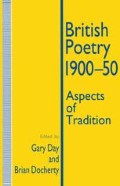Abstract
‘One of the anomalies of criticism in the late twentieth century’, the American critic Marjorie Perloff has recently stated, ‘is that the lyric poem, the great genre of the Romantics, as of the High Modernists, no longer seems central to its discourse.’1 Whether we agree with Perloff’s implicit judgement of the importance of the lyric form or not, her comment reminds us that the radical transposition of the lyric — particularly of the High Modernist lyric — from centre to margin is one of the most notable events in the recent history of literary criticism. For forty years, from the early 1920s to the late 1960s, the lyrics of Yeats and Eliot enjoyed an almost unimaginable prestige in Anglo-American letters. They provided the models which younger poets, from Auden to Plath, sought to emulate; they inspired in Practical and New Criticism institutionally powerful and influential doctrines of criticism; and they constituted for many critics the poles within which poetic writing itself was deemed possible. So overpowering was their prestige that few thought odd the view that the significant history of English literature was to be found in the development of the lyric.
Access this chapter
Tax calculation will be finalised at checkout
Purchases are for personal use only
Preview
Unable to display preview. Download preview PDF.
Notes
Marjorie Perloff, ‘New Nouns for Old: “Language” Poetry, Language Game, and the Pleasure of the Text’, in Matei Calinescu and Douwe Fokkema (eds), Exploring Postmodernism: Selected Papers presented at a Workshop on Postmodernism at the XIth International Comparative Literature Congress, Paris, 20–24 August 1985 (Amsterdam/Philadelphia: John Benjamins Publishing Co., 1987) p. 95.
Marjorie Perloff, The Poetics of Indeterminacy: Rimbaud to Cage (Princeton, N.J.: Princeton University Press, 1981) p. 16.
Roland Barthes, Mythologies, selected and translated from the French by Annette Lavers (London: Jonathan Cape, 1972) p. 133.
For a recent discussion, see Patrick Williams, ‘Cultural Coherence and Contradiction in Yeats’, and Mick Burton, ‘The Imperfect Librarian: Text and Discourse in The Waste Land and Four Quartets’, in David Murray (ed.), Literary Theory and Poetry: Extending the Canon (London: Batsford, 1989). Burton’s essay is particularly useful for its analysis of the ways in which the ‘woman reader’ of Eliot is ‘hailed as inferior’.
Paul de Man, ‘Semiology and Rhetoric’, Allegories of Reading: Figural Language in Rousseau, Nietzsche, Rilke, and Proust (New Haven: Yale University Press, 1979) pp. 3–19.
See Geoffrey Galt Harpham, The Ascetic Imperative in Culture and Criticism (Chicago: Chicago University Press, 1987) pp. 3–66.
Maud Ellmann, The Poetics of Impersonality: T. S. Eliot and Ezra Pound (Brighton: Harvester Press, 1987) pp. 62–90.
Ruth Nevo, ‘The Waste Land: Ur-Text of Deconstruction’, New Literary History, 13:3 (Spring 1982) pp. 453–61.
Geoffrey H. Hartman, Saving the Text: Literature/Derrida/Philosophy (Baltimore: Johns Hopkins University Press, 1981) p. 2.
See, for a brief account of responses to deconstruction, Howard Felperin, ‘The Anxiety of American Deconstruction’, in Rajnath (ed.), Deconstruction: A Critique (London: Macmillan, 1989) pp. 180–96.
See, for a discussion of the centrality of Yeats to Bloom and de Man, Daniel O’Hara, ‘Yeats in Theory’, in Richard Machin and Christopher Norris (eds), Post-structuralist Readings of English Poetry (Cambridge: Cambridge University Press, 1987) pp. 349–68. For a discussion of the centrality of Yeats to Hartman, see Daniel O’Hara, The Romance of Interpretation: Visionary Criticism from Pater to de Man (New York: Columbia University Press, 1985) pp. 98–146.
See, for a discussion of the centrality of Yeats to Bloom and de Man, Daniel O’Hara, ‘Yeats in Theory’, in Richard Machin and Christopher Norris (eds), Post-structuralist Readings of English Poetry (Cambridge: Cambridge University Press, 1987) pp. 349–68. For a discussion of the centrality of Yeats to Hartman, see Daniel O’Hara, The Romance of Interpretation: Visionary Criticism from Pater to de Man (New York: Columbia University Press, 1985) pp. 98–146.
Paul de Man, ‘Literary History and Literary Modernity’, Blindness and Insight: Essays in the Rhetoric of Contemporary Criticism (London: Methuen, 2nd rev. edn, 1983) pp. 161–2.
Harry Blamires, Word Unheard: A Guide Through T. S. Eliot’s Four Quartets (London: Methuen, 1969) p. 143.
See Genesius Jones, Approach to the Purpose: A Study of the Poetry of T. S. Eliot (London: Hodder and Stoughton, 1964) p. 265: ‘The Kingdom finally comes, and the Earthly Paradise is realised in a transcendent form as the Kingdom of the Son, when the Holy Spirit invades the earth. And it is this invasion which Mr. Eliot celebrates in Little Gidding. The figure of the invasion is the Luftwaffe. But it is precisely the Stuka bomber — “The dark dove with the flickering tongue” — which is the agent of the Holy Spirit.’
A. D. Moody speaks of a ‘rhetorical ultimatum’ in T. S. Eliot: Poet (Cambridge: Cambridge University Press, 1980) p. 256.
They perform an aestheticist reading, of the kind analysed by Allan Megill, Prophets of Extremity: Nietzsche, Heidegger, Foucault, Derrida (Berkeley and Los Angeles: California University Press, 1985). A Derridian reading would pose questions about the cultural effects, not least of inclusion and exclusion, following from the ‘onto-theology’ of Four Quartets. Purification through fire has different connotations for those identifying with the purifying force and for those identifying with its victims.
Editor information
Editors and Affiliations
Copyright information
© 1995 Palgrave Macmillan, a division of Macmillan Publishers Limited
About this chapter
Cite this chapter
Davies, A. (1995). Deconstructing the High Modernist Lyric. In: Day, G., Docherty, B. (eds) British Poetry, 1900–50. Palgrave Macmillan, London. https://doi.org/10.1007/978-1-349-24000-5_7
Download citation
DOI: https://doi.org/10.1007/978-1-349-24000-5_7
Publisher Name: Palgrave Macmillan, London
Print ISBN: 978-0-333-53279-9
Online ISBN: 978-1-349-24000-5
eBook Packages: Palgrave Literature & Performing Arts CollectionLiterature, Cultural and Media Studies (R0)

